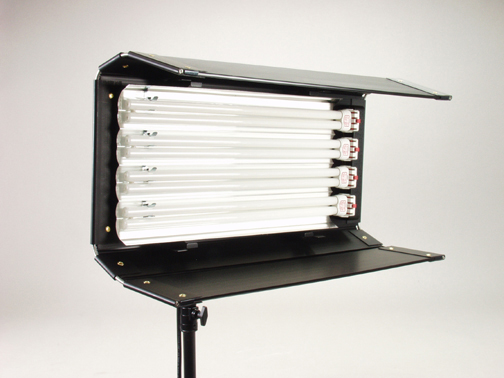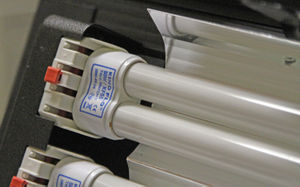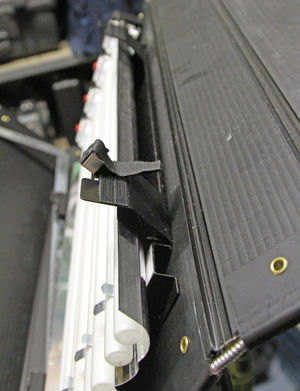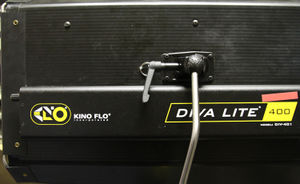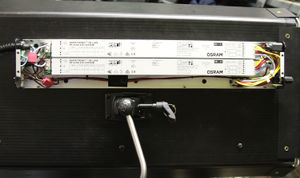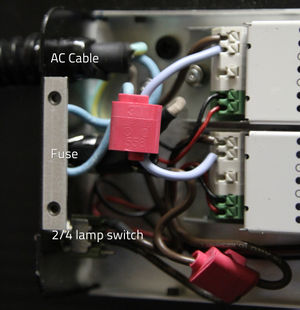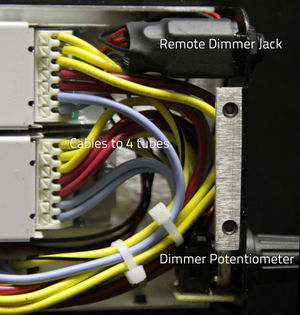DIY Flourescent Area Light
1 Disclaimer
This page is the result of the discussion that started on the apertus forums: http://www.apertus.org/forums/viewtopic.php?f=4&t=662
Currently it is a collection of information plus guides to actually build one of these DIY lamps.
As always with DIY products that use electricity: be careful - don't kill yourself or your cast and crew - hands off if you don't know what you are doing!
2 Facts
2.1 General
- Normal fluorescent lights as they are used in buildings, parking lots, offices, etc. are unsuited as they mostly have traditional magnetic ballasts that flicker with twice the grid frequency (100/120 Hz) and this gives a pumping or flicker effect when shooting video. So what we need are high speed electronic ballasts (35-45 KHz), also called ECG (electronic control gear). At this frequency the flickering overlaps and this leads to a constant light flux with no noticeable fluctuations in light intensity.
- Magnetic ballasts require a starter for heating up the bulb filaments prior to discharging it, ECG's have that function build in.
- The ECG provides a high initial voltage pulse to initiate the discharge, then rapidly limits the lamp current to safely sustain the discharge.
- Magnetic ballasts have a heavy choke, can be dimmed with a variac (autotransformer), make a humming noise, are fairly heavy, are less efficient, give the lamp a shorter life and have no safety features for protection in case of component failing.
- ECG's don't need a choke since current limitation happens electronically, can be dimmed with various techniques (see dimming section), make less noise, are rather light, are more efficient, give the lamp a longer life and go in safe modes when components fail or are absent.
- Magnetic ballasts used to be manufactured in three options: preheat, rapid start, and instant start. Quality ECG's nowadays are almost all rapid start. Depending on temperature, bulb life, whether lamp had been powered short time ago, there is always a certain delay in that startup (<1s). Kino Flo professional ballasts made by the company (not the ones in the Diva fixture) though, have a instant start which likely shortens the lamp life, since that probably implies a insane lighting strike inside the bulb.
- Fluorescent lighting is not suited for fast switching like strobe effects due to the working principle and chemistry inside.
2.2 Color Rendition Index (CRI)
The first number (in 930 & 954) is the color rendition level.
9 = 90%+ color rendition fidelity (see http://en.wikipedia.org/wiki/Fluorescent_lamp#Color_rendering_index).
Kino were the first to manufacture tubes with this 95+% color rendition fidelity which might be even better than the one by Osram outlined here.
Note that you can buy those kinoflo tubes "spare part" also, in the same price range (http://www.filmandvideolighting.com/2ft55tub6pac.html) - though we do not know if the Kinoflo ballast treats the tubes in a special way that enables/improves their performance.
One must understand that a PLL bulb (like dulux series) is in practice inferior to T5 and T8 bulbs of the same CRI rating. That is because fluorescent lights are very sensitive to heat. Heat dissipation is therefor key and must certainly be taken into consideration when positioning the lamps. A dulux-type bulb for instance will change in color when positioned upright and that effect will increase as when the foot of the lamp is at the bottom size when vertically mounted. That effect is less noticable with T5 and T8 technology. In fact, T8 is the most superior lamp because in comparison to T8, heat dissipation is taken into account.
A common misconception is that CRI is the only way to rate a lamp in terms of color quality when using a photo technique such as film or video. One must know that two high-CRI lamps can still be very different in color tests. One must understand that a non-linear spectrum can cause content-sensitive subjects such as human skin to be portrayed unnatural or unpleasing. Technologies such as HMI and T8 and T5 fluorescent are still superior to phosphor-corrected high-CRI LED's and PLL because the spectrum suffers less 'spikes' in human-sensitive areas as skintones.
Also one must note that a particular light mostly doesn't come alone on a filmset for instance. Many times multiple units must light along eachother. The problem of batching (which comes with LED's) means that it is very likely to find the same units of the same rating from the same manufacturer will have a different spectrum.
Color quality, white balance and CRI diminishes with almost all discharge-types of lamps such as HMI and fluorescent. While this process is slow, in practical terms this is of lesser concern since lamps can be filter-corrected.
One must note that color filtering by means of color gel does not solve the problem of 'bad' CRI. A part of the spectrum can be arbitrary balanced, so a particular color on set will look ok, but that gel will not work for other colors.
2.3 Tube designations
When you research fluorescent tubes you will immediately stumble over designations like T8, T5 or T12.
Quite simply, "T" is the diameter of the tube. A T12 bulb will have a diameter of 12/8" (3.81cm).
Please note that the recommended tubes above are twin tube designs and do not follow the T standard.
Typically the more narrow the lamp, the more efficient and the more expensive it will be. Different designations also use different socket types (from http://en.wikipedia.org/wiki/Fluorescent-lamp_formats):
| Designation | Tube diameter | Extra | |||
|---|---|---|---|---|---|
| (in) | (mm) | Socket | Notes | ||
| T2 | 1/4" approx. | 7 | WP4.5x8.5d | Osram Fluorescent Miniature (FM) tubes only Havells Sylvania Luxline Slim T2 Linear | |
| T4 | 1/2" | 12,7 | G5 bipin | Slim lamps. Power ratings and lengths not standardized (and not the same) between different manufacturers | |
| T5 | T16 | 5/8" | 15,9 | G5 bipin | Original 4–13 W range from 1950s or earlier. |
| T8 | T26 | 1 | 25,4 | G13 bipin/single pin/recessed double contact | Currently not available in 3200K (tungsten) color. Will require correcting filters such as CTO 1/4 or 1/2 on a 4200K bulb. |
| T9 | T29 | 1 1/8" | G10q quadpin contact | Circular fluorescent tubes only | |
| T10 | 1 1/4" | G13 bipin | |||
| T12 | T38 | 1 1/2" | G13 bipin/single pin/recessed double contact | not as efficient as new lamps | |
2.4 Rigging
Kino Flo uses OmniMount speaker mounts with plastic ball mount (so called "lollipop") on the smaller fixtures. Unlike the Diva, most units have a quick snap mounting plate that is both easy to fasten and loosen. These are made by Kino Flo and consist of a aluminum plate with a spring-loaded pin and T-shape pins that guide in the receptable plate, mounted on to the fixture.
2.5 Barndoors and Grid
A grid is a valuable tool for directing soft light without the need of many flags. The grids on most Kino Flo units are made of plastic and are not reenforced at the sides where they break easily. Also the velcro attachment is not very strong. The plastic used by Kino Flo must be somekind of construction material. We haven't found the exact usage for it yet. It is available in many colors, and is rather expensive. Of course, we are only interested in the black ones.
Barndoors on a Kino Flo are made of Biplex (comes by many names). It is a isolation construction material. Biplex is cheap and strong. Good for the purpose of a barndoor. The hinges though, are made of steel strip wound reenforced solid copper core wire. It breaks after a few months of use. Also, since it acts as a spring, you end up overbending before getting a right angle.
One must not that barndooring a soft source is generally bad practice. Since the nature of the light, you can not easily 'cut' soft light, certainly not with a flag nearby or even worse, a barndoor. When you barndoor a Kino Flo, what you actually do is make it a harder source and reducing light.
Therefore, a combination of having a soft light with a grid makes it spread across a subject, yet remain directional.
Advanced practice: When used very nearby, in a certain case that the size of the subject is a fraction of the size of the lightsource, one can reduce the inherit 'source-ness' of a light. The sourceness is a mostly unwanted characteristic of a set light whereby the audience can 'feel' the lightsource in the scene. One of the reasons of that effect is that noticeble, is in a scene where the subject walks towards a lightsource such as a window. If the source is placed very nearby, light will increase fast. When using a grid, the outer parts of a nearby source degrade in their ability to reach the subject, thus even out the effect.
2.6 Ballast
- Dimmable ballasts are in general more expensive (50-90€) than non dimmable ones (20-30€)
- The ballast needs to match the watts of the used fluorescent tube. That is because a certain wattage requires a inrush current and voltage to heat up the bulb that is specific. Experiments with T8 bulbs and higher wattage ballasts, have proven it is possible to let the lamp burn nominally whitout problem, though shortened lamp life is possible (not a big concern for film use, since in practice lamps break faster by human intrusion).
- Some ballasts can supply multiple tubes (indicated with markings like "2x58W"). Two, three or four bulbs is common.
- The Osram ballasts matching the Dulux L series are called T8 high frequency electronic ballast: QUICKTRONIC
- The Oscram Quicktronic dimmable ballasts have a digital interface (called DALI) that lets you control the lamps electronically: http://en.wikipedia.org/wiki/Digital_Addressable_Lighting_Interface
The advantage over 1-10V is that DALI can control the lamp to be switched off. 0% dimming means that the lamp is still lit. <- Arduino based wireless light control over bluetooth anyone?
- There are many 1-10V electronic dimmable ballasts in many power ratings available from such manufacturers as Phillips and Osram. Unlike the analog 0-10V dimmers, these units provide voltage, so one can easily dim them by putting a potentiometer in series. The way to dim them with an Arduino, is by means of a mosfet. For using one potmeter to dim multiple units, simply put the analog inputs in series. To do the opposite (which is preferable as explained in the dimming section), one can use a common '-' cable for all the ballasts, which saves in cabling.
- Ballast to bulb cable length is limited. That is one of the reasons why Kino Flo designed their own ECG's when they wanted to use remote ballasts that are up to 25m or so away from the heads. When we come to the point that we want to design or own ECG's, we may need to reverse engineer a Kino Flo Select4 ECG for examining what is necessairy for extended ballast to bulb cable length.
2.7 Dimming
Let's state this: dimming drastically affects color quality (balance and/or CRI) in a way. If you can avoid it (by using Neutral Density gel for instance), do it that way. But for quick fixes it can be a charm. Fluorescents don't dim al the way down to zero.
2.8 Energy Efficiency
Everyone talks about LEDs recently and how they are going to replace traditional light bulbs.
But lets take a look at the facts:
2.8.1 The Theory
Wikipedia: http://en.wikipedia.org/wiki/Luminous_efficacy
The luminous coefficient is luminous efficiency expressed as a value between zero and one, with one corresponding to an efficacy of 683 lm/W.
So the maximum physically possible output of one Watt of electric power are 683 Lumens of light. Depending on this efficiency the rest of energy is converted to heat rather than photons/light.
| Lamp Type | Luminous Coefficient |
|---|---|
| Candle | 0.04% |
| Tungsten Incandescent Bulb | 2 - 3% |
| Tungsten Halogen | 2.5 - 3.5% |
| LED | 0.7 - 25% |
| Fluorescent Tube | 9 - 15% |
| HMI | 9.5 – 17% |
So Fluorescent Tubes are just as energy efficient as LEDs and have been around for quite some time already.
http://www.youtube.com/watch?v=O7LNXLu9Z6g
http://www.youtube.com/watch?v=uIxy6p4kzd0
4 Kinoflo Diva 401 Tear Down
We were very curious what was hiding inside the Diva light enclosure, what electronics we would discover there and what other parts they used.
5 Building the DIY Flourescent Area Light
5.1 Tubes
Tubes that some DIY cinematographers are already using:
- Osram Dulux L 55w 930 (Tungsten)
- Osram Dulux L 55w 954 (Daylight)
or 100% compatible:
- Philips Master PL-L 930 4P (Tungsten)
- Philips Master PL-L 950 4P (Daylight)
These cost around 6 - 20€ each and are easy to source locally.
They all use a 2G11 socket.
Dulux L lamps are specially designed for television studio lighting. They claim to provide high lumen packages and offer excellent color stability, even when dimmed down to 50%. The special phosphor allow them to seamlessly blend in with the light from other tungsten (warm) or metal halide (daylight) lamps on the set.
5.2 Ballast
We ordered the identical ballast as used in the Kinoflo Diva Lite: Osram Quicktronic DELUXE HF 2x58W DIM
5.3 Holder
Vossloh Schwabe is a quality manufacturer of lampholders.
5.4 Electrical Wiring
On the ballast connect power grid to 1,2 and 4 to earth. Leave dimming pins unconnected for testing (later you can put potentiometer between those pins to dim the tubes.
Connect tubes with the following wiring:
